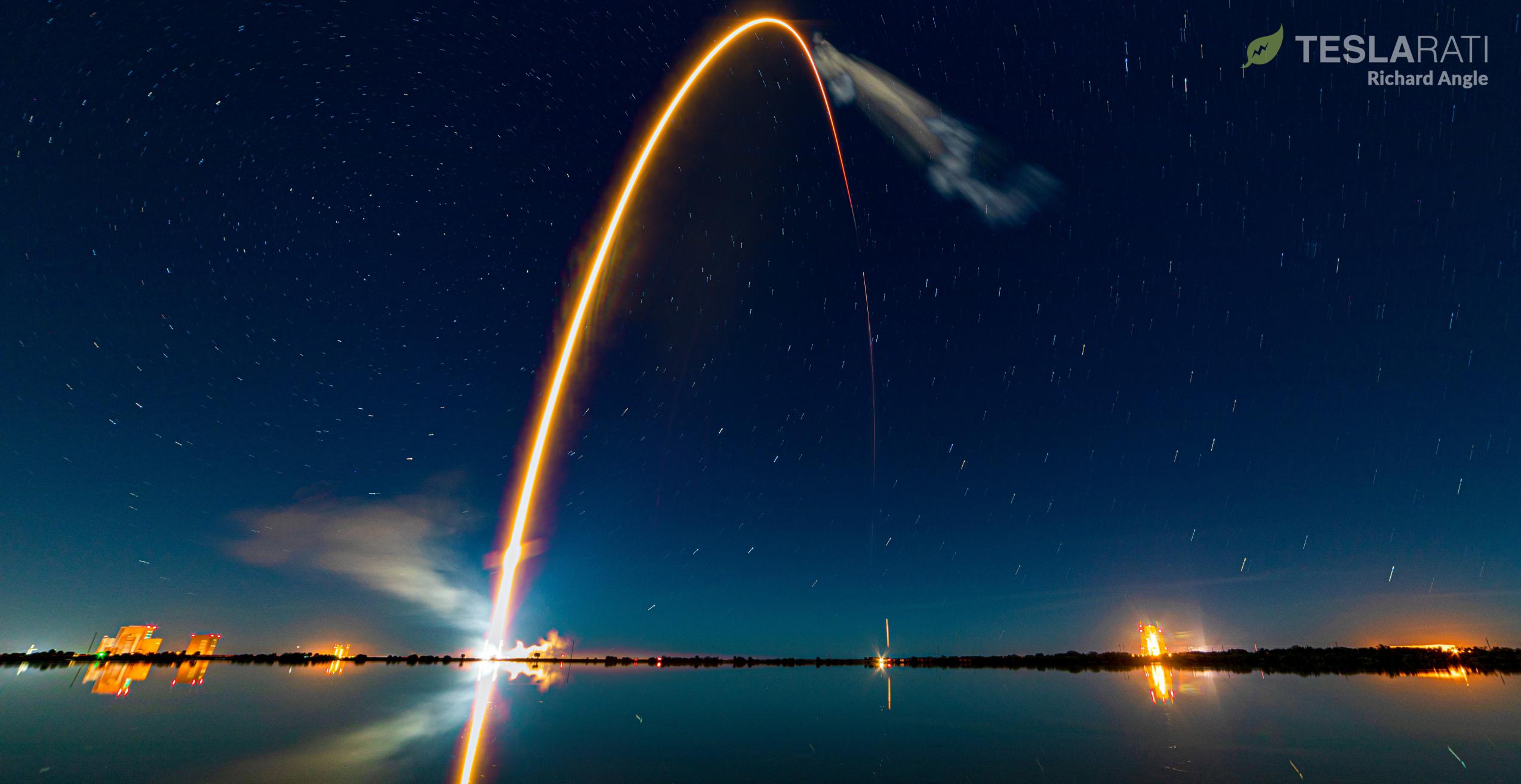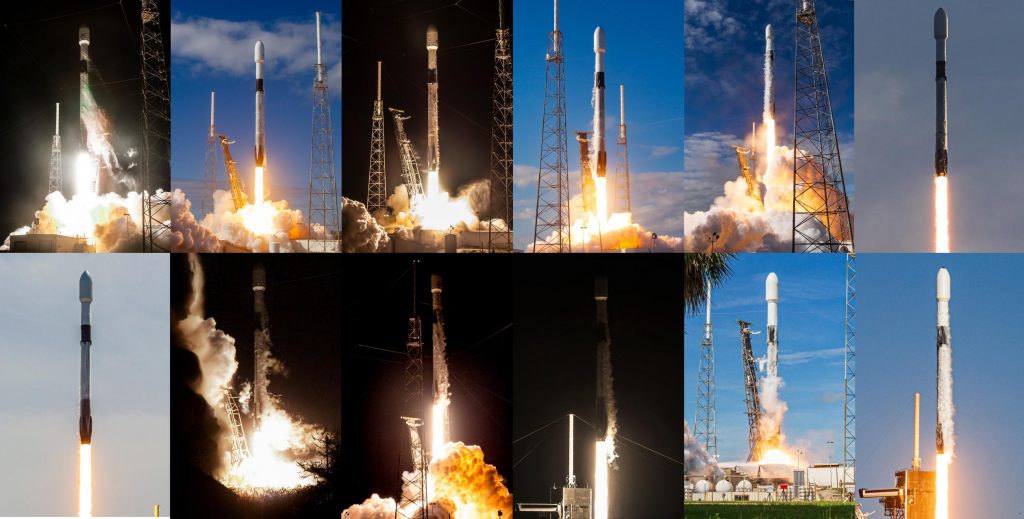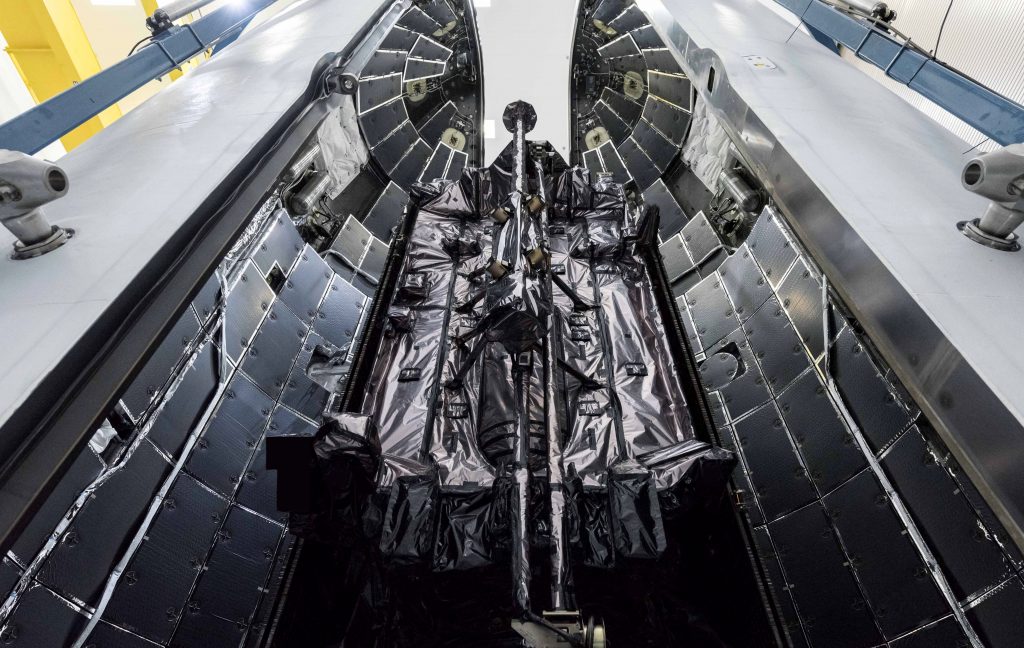

News
SpaceX adds mystery Falcon 9 launch to packed October manifest
SpaceX FCC paperwork has revealed the addition of an unidentified Falcon 9 launch to the company’s packed October manifest, ranging from several Starlink missions to Crew Dragon’s first operational astronaut launch.
Under the US Federal Communications Commission (FCC), companies must submit an application for permission to communicate with their rocket for every single launch. While a major annoyance for those companies and an undeniably clunky process, those applications for “special temporary authority” (STAs) to communicate are one of the only ways members of the public can independently monitor and forecast US launch activities. For SpaceX, the company typically applies for multiple STAs for every single launch, including specific applications for booster launches, landings, and preflight ground tests.
The separate STAs can be connected with a “Mission Number” SpaceX associates each one with, while coordinates included to designate the area of landing communications (i.e. the drone ship recovery zone) often reveals a mission’s trajectory. Combined, STAs can often be used to identify the exact mission (i.e. a Starlink launch, Crew Dragon, etc.). STAs for SpaceX’s upcoming Crew Dragon Crew-1 and Cargo Dragon CRS-21 missions, as well as several Starlink launches, have already been identified.

Thanks to bad weather and a flurry of ULA delays, SpaceX’s October manifest is currently packed with three Starlink missions, a GPS III satellite launch for the US military, and Crew Dragon’s first operational astronaut mission to the International Space Station (ISS). Barring a miracle, ULA’s latest Delta IV Heavy launch delay has pushed SpaceX’s GPS III SV04 mission to October 1st.

Starlink-12 – SpaceX’s 11th Starlink mission this year and 13th overall – is tentatively set to follow GPS III SV04 at 9:17 am EDT (13:17 UTC) on October 1st. Starlink-13 and Starlink-14 are then scheduled to launch no earlier than mid-to-late-October. Finally, SpaceX and NASA are in the final stages of preparing for Crew Dragon’s Crew-1 mission – the spacecraft’s first operational delivery of astronauts to the ISS – as soon as October 31st (Halloween).
A new Sirius XM radio satellite (SXM-7) could launch on a Falcon 9 rocket on November 6th. On the West Coast, SpaceX’s first California mission since June 2019 could launch on November 10th. SpaceX and NASA are also targeting the launch debut of an upgraded Cargo Dragon 2 resupply spacecraft on a mission known as CRS-21, scheduled to lift off NET November 15th. Last but assuredly not least, Turkey’s Turksat 5A communications satellite could launch as early as November 31st. No Starlink missions are currently scheduled in November but it’s safe to assume that there will be at least one or two. Altogether, SpaceX already has five launches scheduled in October and four set for November. While undeniably prolific, SpaceX has never launched more than three times in one month.

Now, on top of that swath of firm launches, mysterious “SpaceX Mission 1512” has joined the fray. Based on the FCC STA request, the mission is scheduled to launch no earlier than (NET) October 3rd (with a six-month window) and will include a return-to-launch-site (RTLS) Falcon 9 booster landing. The RTLS landing in particular substantially constrains the mission and means – right off the bat – that it can’t be for Starlink, while also ruling out Cargo Dragon CRS-21 (an RTLS landing STA already exists) and Crew Dragon Crew-1 (drone ship landing). Simply put, an RTLS rules out every other launch on SpaceX’s 2020 manifest beyond a rideshare mission tentatively scheduled in December, and SpaceX almost never files for STAs months in advance.
That leaves some kind of unannounced, mystery mission. Only once in SpaceX’s history has the company conducted an unannounced launch – unsurprisingly for some unknown branch of the US military or espionage apparatus. Known as Zuma and still shrouded in secrecy, it followed an almost identical pattern, revealed only through FCC launch and landing communications requests and rumors in 2017 before a January 2018 launch. Although Northrop Grumman was thrown under the bus for a failed payload adapter that may or may not have doomed the satellite, no federal agency has taken credit for the mission – unspeakably odd as far as spaceflight goes.
At the time, unofficial rumors published on Reddit implied that Zuma would only be the first of many similar missions. The claimed failure of a spring-like deployment mechanism and loss of spacecraft – believed to be worth one or several billion dollars – just hours after launch would have unsurprisingly thrown a wrench into those gears. Now, almost three years later and in the midst of an exceptionally busy period of several important launches, could SpaceX be preparing for Zuma-2?
Check out Teslarati’s Marketplace! We offer Tesla accessories, including for the Tesla Cybertruck and Tesla Model 3.
Elon Musk
Tesla Supercharger Diner food menu gets a sneak peek as construction closes out
What are you ordering at the Tesla Diner?

The Tesla Supercharger Diner in Los Angeles is nearing completion as construction appears to be winding down significantly. However, the more minor details, such as what the company will serve at its 50s-style diner for food, are starting to be revealed.
Tesla’s Supercharger Diner is set to open soon, seven years after CEO Elon Musk first drafted the idea in a post on X in 2018. Musk has largely come through on most of what he envisioned for the project: the diner, the massive movie screens, and the intended vibe are all present, thanks to the aerial and ground footage shared on social media.
We already know the Diner will be open 24/7, based on decals placed on the front door of the restaurant that were shared earlier this week. We assume that Tesla Optimus will come into play for these long and uninterrupted hours.
The Tesla Diner is basically finished—here’s what it looks like
As far as the food, Tesla does have an email also printed on the front door of the Diner, but we did not receive any response back (yet) about what cuisine it will be offering. We figured it would be nothing fancy and it would be typical diner staples: burgers, fries, wings, milkshakes, etc.
According to pictures taken by @Tesla_lighting_, which were shared by Not a Tesla App, the food will be just that: quick and affordable meals that diners do well. It’s nothing crazy, just typical staples you’d find at any diner, just with a Tesla twist:
Tesla Diner food:
• Burgers
• Fries
• Chicken Wings
• Hot Dogs
• Hand-spun milkshakes
• And more https://t.co/kzFf20YZQq pic.twitter.com/aRv02TzouY— Sawyer Merritt (@SawyerMerritt) July 17, 2025
As the food menu is finalized, we will be sure to share any details Tesla provides, including a full list of what will be served and its prices.
Additionally, the entire property appears to be nearing its final construction stages, and it seems it may even be nearing completion. The movie screens are already up and showing videos of things like SpaceX launches.
There are many cars already using the Superchargers at the restaurant, and employees inside the facility look to be putting the finishing touches on the interior.
🚨 Boots on the ground at the Tesla Diner:
— TESLARATI (@Teslarati) July 17, 2025
It’s almost reminiscent of a Tesla version of a Buc-ee’s, a southern staple convenience store that offers much more than a traditional gas station. Of course, Tesla’s version is futuristic and more catered to the company’s image, but the idea is the same.
It’s a one-stop shop for anything you’d need to recharge as a Tesla owner. Los Angeles building permits have not yet revealed the date for the restaurant’s initial operation, but Tesla may have its eye on a target date that will likely be announced during next week’s Earnings Call.
News
Tesla’s longer Model Y did not scale back requests for this vehicle type from fans
Tesla fans are happy with the new Model Y, but they’re still vocal about the need for something else.

Tesla launched a slightly longer version of the Model Y all-electric crossover in China, and with it being extremely likely that the vehicle will make its way to other markets, including the United States, fans are still looking for something more.
The new Model Y L in China boasts a slightly larger wheelbase than its original version, giving slightly more interior room with a sixth seat, thanks to a third row.
Tesla exec hints at useful and potentially killer Model Y L feature
Tesla has said throughout the past year that it would focus on developing its affordable, compact models, which were set to begin production in the first half of the year. The company has not indicated whether it met that timeline or not, but many are hoping to see unveilings of those designs potentially during the Q3 earnings call.
However, the modifications to the Model Y, which have not yet been officially announced for any markets outside of China, still don’t seem to be what owners and fans are looking forward to. Instead, they are hoping for something larger.
A few months ago, I reported on the overall consensus within the Tesla community that the company needs a full-size SUV, minivan, or even a cargo van that would be ideal for camping or business use.
Tesla is missing one type of vehicle in its lineup and fans want it fast
That mentality still seems very present amongst fans and owners, who state that a full-size SUV with enough seating for a larger family, more capability in terms of cargo space for camping or business operation, and something to compete with gas cars like the Chevrolet Tahoe, Ford Expedition, or electric ones like the Volkswagen ID.BUZZ.
We asked the question on X, and Tesla fans were nearly unanimously in support of a larger SUV or minivan-type vehicle for the company’s lineup:
🚨 More and more people are *still* saying that, despite this new, longer Model Y, Tesla still needs a true three-row SUV
Do you agree? https://t.co/QmbRDcCE08 pic.twitter.com/p6m5zB4sDZ
— TESLARATI (@Teslarati) July 16, 2025
Here’s what some of the respondents said:
100% agree, we need a larger vehicle.
Our model Y is quickly getting too small for our family of 5 as the kids grow. A slightly longer Y with an extra seat is nice but it’s not enough if you’re looking to take it on road trips/vacations/ kids sports gear etc.
Unfortunately we…
— Anthony Hunter (@_LiarsDice_) July 17, 2025
Had to buy a Kia Carnival Hybrid because Tesla doesn’t have a true 3 row vehicle with proper space and respectable range. pic.twitter.com/pzwFyHU8Gi
— Neil, like the astronaut (@Neileeyo) July 17, 2025
Agreed! I’m not sure who created this but I liked it enough to save it. pic.twitter.com/Sof5nMehjS
— 🦉Wise Words of Wisdom – Inspirational Quotes (IQ) (@WiseWordsIQ) July 16, 2025
Tesla is certainly aware that many of its owners would like the company to develop something larger that competes with the large SUVs on the market.
However, it has not stated that anything like that is in the current plans for future vehicles, as it has made a concerted effort to develop Robotaxi alongside the affordable, compact models that it claims are in development.
It has already unveiled the Robovan, a people-mover that can seat up to 20 passengers in a lounge-like interior.
The Robovan will be completely driverless, so it’s unlikely we will see it before the release of a fully autonomous Full Self-Driving suite from Tesla.
Energy
Tesla launches first Virtual Power Plant in UK – get paid to use solar
Tesla has launched its first-ever Virtual Power Plant program in the United Kingdom.

Tesla has launched its first-ever Virtual Power Plant program in the United Kingdom. This feature enables users of solar panels and energy storage systems to sell their excess energy back to the grid.
Tesla is utilizing Octopus Energy, a British renewable energy company that operates in multiple markets, including the UK, France, Germany, Italy, Spain, Australia, Japan, New Zealand, and the United States, as the provider for the VPP launch in the region.
The company states that those who enroll in the program can earn up to £300 per month.
Tesla has operated several VPP programs worldwide, most notably in California, Texas, Connecticut, and the U.S. territory of Puerto Rico. This is not the first time Tesla has operated a VPP outside the United States, as there are programs in Australia, Japan, and New Zealand.
This is its first in the UK:
Our first VPP in the UK
You can get paid to share your energy – store excess energy in your Powerwall & sell it back to the grid
You’re making £££ and the community is powered by clean energy
Win-win pic.twitter.com/evhMtJpgy1
— Tesla UK (@tesla_uk) July 17, 2025
Tesla is not the only company that is working with Octopus Energy in the UK for the VPP, as it joins SolarEdge, GivEnergy, and Enphase as other companies that utilize the Octopus platform for their project operations.
It has been six years since Tesla launched its first VPP, as it started its first in Australia back in 2019. In 2024, Tesla paid out over $10 million to those participating in the program.
Participating in the VPP program that Tesla offers not only provides enrolled individuals with the opportunity to earn money, but it also contributes to grid stabilization by supporting local energy grids.
-

 Elon Musk1 day ago
Elon Musk1 day agoWaymo responds to Tesla’s Robotaxi expansion in Austin with bold statement
-

 News1 day ago
News1 day agoTesla exec hints at useful and potentially killer Model Y L feature
-

 Elon Musk2 days ago
Elon Musk2 days agoElon Musk reveals SpaceX’s target for Starship’s 10th launch
-

 Elon Musk3 days ago
Elon Musk3 days agoTesla ups Robotaxi fare price to another comical figure with service area expansion
-

 News1 day ago
News1 day agoTesla’s longer Model Y did not scale back requests for this vehicle type from fans
-

 News1 day ago
News1 day ago“Worthy of respect:” Six-seat Model Y L acknowledged by Tesla China’s biggest rivals
-

 News2 days ago
News2 days agoFirst glimpse of Tesla Model Y with six seats and extended wheelbase
-

 Elon Musk2 days ago
Elon Musk2 days agoElon Musk confirms Tesla is already rolling out a new feature for in-car Grok
















